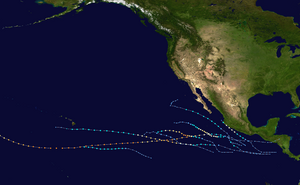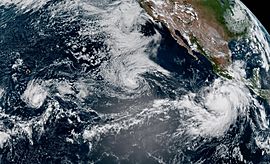2023 Pacific hurricane season facts for kids

The 2023 Pacific hurricane season is the current Pacific hurricane season in the Northern Hemisphere. It officially began on May 15 in the eastern Pacific (east of 140°W), and on June 1 in the central Pacific (from 140°W to the International Date Line); both will end on November 30. These dates, adopted by convention, historically describe the period in each year when most tropical cyclogenesis occurs in these regions of the Pacific. There was no tropical cyclone activity in the basin for the first six weeks of the season, making this one of the latest-starting seasons on record. When the first system, Hurricane Adrian, developed on June 27, it became the second-latest forming first named storm in the eastern Pacific in the satellite era (since 1971), behind only Tropical Storm Agatha in 2016.
The first major hurricane of the season was Hurricane Calvin, which formed southwest of the southwestern coast of Mexico, and passed just south of the Island of Hawai‘i as a tropical storm, bringing widespread rainfall to the island and to neighboring Maui. The strongest systems so far this season have been Category 4 hurricanes Dora and Fernanda. Dora followed a similar track as Calvin, and passed further to the south of Hawai‘i, but at near-peak intensity. The interaction between Dora and a high-pressure area north of the Hawaiian Islands generated strong gradient winds over the islands which in turn fanned the flames of multiple devastating wildfires. Moreover, Dora became the first tropical cyclone to cross the International Date Line into the Western Pacific since Hector in 2018, and only the second on record to remain at hurricane strength across the eastern, central and western Pacific basins, along with John in 1994.
Seasonal forecasts
| Record | Named storms |
Hurricanes | Major hurricanes |
Ref | |
|---|---|---|---|---|---|
| Average (1991–2020): | 15 | 8 | 4 | ||
| Record high activity: | 1992: 27 | 2015: 16 | 2015: 11 | ||
| Record low activity: | 2010: 8 | 2010: 3 | 2003: 0 | ||
| Date | Source | Named storms |
Hurricanes | Major hurricanes |
Ref |
| May 4, 2023 | SMN | 16–22 | 7–11 | 3–5 | |
| May 25, 2023 | NOAA | 14–20 | 7–11 | 4–8 | |
| Area | Named storms |
Hurricanes | Major hurricanes |
Ref | |
| Actual activity: | EPAC | 8 | 6 | 4 | |
| Actual activity: | CPAC | 0 | 0 | 0 | |
| Actual combined activity: | 8 | 6 | 4 | ||
In advance of each Pacific hurricane season, forecasts of hurricane activity are issued by the United States National Oceanic and Atmospheric Administration (NOAA)'s Climate Prediction Center and Mexico's the Servicio Meteorológico Nacional (SMN). They include weekly and monthly changes in significant factors that help determine the number of tropical storms, hurricanes, and major hurricanes within a particular year. According to NOAA, the average eastern Pacific hurricane season between 1991 and 2020 contained roughly 15 tropical storms, 8 hurricanes, 4 major hurricanes, with a near-normal accumulated cyclone energy (ACE) index between 80 and 115. Broadly speaking, ACE is a measure of the power of a tropical or subtropical storm multiplied by the length of time it existed. It is only calculated for full advisories on specific tropical and subtropical systems reaching or exceeding wind speeds of 39 mph (63 km/h). NOAA typically categorizes a season as above-average, average, or below-average based on the cumulative ACE index, but the number of tropical storms, hurricanes, and major hurricanes within a hurricane season is sometimes also considered.
On May 4, 2023, SMN issued its forecast for the season, forecasting a total of 16–22 named storms developing, with 7–11 hurricanes, and 3–5 major hurricanes. Factors they expected to increase activity were above-average sea surface temperatures across the eastern Pacific and the El Niño–Southern Oscillation (ENSO) remaining in the neutral phase, with the possibility of a strong El Niño developing. On May 25, 2023, NOAA issued their outlook, calling for an above-normal season with 14–20 named storms overall, 7–11 hurricanes, 4–8 major hurricanes, and an ACE index of 90% to 155% of the median.
Seasonal summary

The first several weeks of this Eastern Pacific hurricane season were quiet, as the first system, Hurricane Adrian, did not develop until June 27. Typically, the first named storm forms around June 10. Two days later, as Adrian moved out into the open Pacific, Hurricane Beatriz formed near and tracked parallel to the Mexican coast. Next came Hurricane Calvin, which formed off the southwestern coast of Mexico during the second week of July and became the first major hurricane of the season as it moved steadily west-northwestward toward Hawaii. Hurricane Dora ushered in August by rapidly intensifying to a Category 4 hurricane, while also tracking toward Hawaii. On August 11, Dora crossed the International Dateline to become only the second tropical cyclone on record to be at hurricane strength in the Eastern, Central and Western Pacific basins, the other being John in 1994. Additionally, Dora maintained Category 4 intensity longer than any Pacific hurricane on record.
Another early August system, short-lived Tropical Storm Eugene, formed and remained well offshore Mexico. It was soon followed by Category 4 Hurricane Fernanda and Tropical Storm Greg; neither system passed near land. Next came Tropical Storm Hilary.
This season's ACE index as of 15:00 UTC on August 17, as calculated by Colorado State University using data from the NHC, is approximately 90.2 units. This number represents sum of the squares of the maximum sustained wind speed (knots) for all named storms while they are at least tropical storm intensity, divided by 10,000. Therefore, tropical depressions are not included.
Season effects
This is a table of all the storms that have formed in the 2023 Pacific hurricane season. It includes their duration, names, landfall(s), denoted in parentheses, damages, and death totals. Deaths in parentheses are additional and indirect (an example of an indirect death would be a traffic accident) but were still related to that storm. Damage and deaths include totals while the storm was extratropical, a tropical wave, or a low, and all the damage figures are in 2023 USD.
| Saffir–Simpson Hurricane Scale | ||||||
| TD | TS | C1 | C2 | C3 | C4 | C5 |
| Storm name |
Dates active | Storm category
at peak intensity |
Max 1-min wind mph (km/h) |
Min. press. (mbar) |
Areas affected | Damage (USD) |
Deaths | Refs
|
||
|---|---|---|---|---|---|---|---|---|---|---|
| Adrian | June 27 – July 2 | Category 2 hurricane | 105 (165) | 970 | Revillagigedo Islands | None | None | |||
| Beatriz | June 29 – July 1 | Category 1 hurricane | 85 (140) | 992 | Western Mexico | Minimal | 0 (1) | |||
| Calvin | July 11–19 | Category 3 hurricane | 125 (205) | 955 | Hawaii | Minimal | None | |||
| Four-E | July 21–22 | Tropical depression | 35 (55) | 1006 | None | None | None | |||
| Dora | July 31 – August 11 | Category 4 hurricane | 145 (230) | 942 | Hawaii, Johnston Atoll | None | None | |||
| Eugene | August 5–7 | Tropical storm | 70 (110) | 992 | Southern Baja California peninsula | None | None | |||
| Fernanda | August 12–17 | Category 4 hurricane | 130 (215) | 955 | None | None | None | |||
| Greg | August 14–18 | Tropical storm | 50 (85) | 1000 | None | None | None | |||
| Hilary | August 16–Present | Category 4 hurricane | 145 (230) | 942 | Western Mexico, Socorro Island | None | None | |||
| Season Aggregates | ||||||||||
| 9 systems | June 27 – Season ongoing | 145 (230) | 942 | Minimal | 0 (1) | |||||
See also
 In Spanish: Temporada de huracanes en el Pacífico de 2023 para niños
In Spanish: Temporada de huracanes en el Pacífico de 2023 para niños
- Weather of 2023
- Tropical cyclones in 2023
- 2023 Atlantic hurricane season
- 2023 Pacific typhoon season
- 2023 North Indian Ocean cyclone season
- South-West Indian Ocean cyclone seasons: 2022–23, 2023–24
- Australian region cyclone seasons: 2022–23, 2023–24
- South Pacific cyclone seasons: 2022–23, 2023–24


